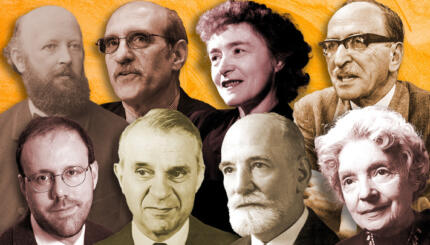Reprinted with permission from the website of Israel’s Ministry of Foreign Affairs.
Yaacov Agam is one of the very few living Israeli artists who have attained international status (he is the only Israeli artist included in H. H. Arnason’s voluminous “History of Modern Art” and in the recent “Dictionary of Art and Artists,” edited by Sir David Piper). As early as the mid-1950s, Agam was considered one of the most important artists of the post-World War II period and a leading pioneer of optic and kinetic art. He is still internationally acknowledged as a major contemporary artist.
Agam (Yaakov Gipstein) was born in 1928 to an Orthodox family in Rishon Lezion in the coastal plain south of Tel Aviv, then a small, semi-rural settlement. His father, Rabbi Yehoshua Gipstein–who devoted his life to Jewish religious learning, meditation, and fasting–refused to register his son in a school, because no place in a religious school was available.…
Consequently, the boy grew up without any formal education and almost without the company of other children. At home, however, Agam absorbed the heritage of Jewish spiritual values and thought and was particularly attracted to Jewish mystic lore and kabbalistic studies as practiced by his father, the learned rabbi. Agam considers himself as his spiritual continuant in his devotion to the study of these values. As we shall see, this heritage remained at the core of much of Agam’s artistic philosophy throughout his career.

Help us keep Jewish knowledge accessible to millions of people around the world.
Your donation to My Jewish Learning fuels endless journeys of Jewish discovery. With your help, My Jewish Learning can continue to provide nonstop opportunities for learning, connection and growth.
Agam began painting as a self-taught teenager. In 1946, he moved to Jerusalem and studied for about two years at the Bezalel Academy of Art. Following the advice of his teacher, the painter Mordecai Ardon, Agam left Bezalel in 1949 and went to Zurich. The stay in Zurich, although of short duration, constitutes a phase of crucial importance in the formation of his style as well as in that of his artistic theory. For it was in Zurich that the young Agam met three men who left their mark on his art and thought for many years to come.
Three Major Influences
The first of them was Johannes Itten (1888-1967), under whom Agam studied at theKunstgewerbe Schule. Itten, a former teacher at the Weimar Bauhaus and of Ardon, was a renowned theoretician of form and color. In his lessons, Itten advocated the use of pure colors and carefully studied coloristic compositions inspired by constructivist ideas. The rational, quasi-scientific basis of Agam’s theoretical approach to the creative process, as well as his constant preference for geometrical forms, pure, bright colors and multi-colored compositions, may thus be traced back to his studies with Itten.
 |
| “Jacob’s Ladder,” by Agam. Image used with permission from the Robert Roman Gallery. |
The second formative influence on Agam was the Swiss painter, sculptor, and designer, Max Bill (b. 1908), who may have inspired Agam’s artistic ideology and work no less than Itten. Bill was one of the leaders of geometric, non-figurative, or abstract art, which he entitled “Concrete Art.” In his theoretical writings, Bill was much concerned with the relationship between aesthetic and mathematical theories, and his ideas appear to have deeply impressed Agam. In addition, it was from Max Bill’s metal sculptures, with their polished, shining forms and precise, geometric style, that Agam inherited his particular approach to sculpture.
The third important source of inspiration was the architectural historian and theoretician, Siegried Giedion–the author of a well-known book, Space, Time and Architecture–whose classes Agam attended at the Zürich Eidgenössische Technische Hochschule.
Giedion advised Agam to continue his studies in Chicago. However, on his way to the United States, and after an intensive study-tour in Italy, he settled in Paris in 1951. In Paris, despite many hardships and utter lack of any financial means, Agam worked and studied indefatigably, also becoming familiar with the contemporary artistic milieu. …
The Element of Time
We have seen that Agam had already been attracted by geometric abstraction when he was studying in Zurich. In Paris, he was equally fascinated by kinetic art, and he soon began to investigate the possibilities of merging the “element of time” into his art, and finally created his own particular version of abstract kinetic art.
In 1952, Agam created his first transformable works with parts that could be moved and change place and position on a panel, thus offering the viewer the possibility of creating innumerable new abstract compositions. Later, in his metal sculptures, Agam applied the same principle of allowing the spectator to take an active part in the creation of new compositions.
In 1953, Agam created his first “polyphonic paintings.” In these works, two or more different abstract compositions are painted on both protruding sides of a relief of a zigzag section, in such a way that one composition is seen when the panel is viewed from the right side, and another when viewed from the left. The frontal view of the panel presents a series of varied compositions which result from the merging–or the “fusion” as Agam calls it–of several main compositions.
Agam transformed this simple device into rich and complex works of art by applying it to his highly developed geometric compositions. Moreover, the spectator perceives not only the gradual merging of one composition into the other but may also comprehend each successive view as a perfectly independent new composition. This way of achieving variety and multiplicity of artistic content in a single work has been constantly developed by Agam throughout his artistic career.
Big Break
Agam’s great opportunity came in 1953, when he exhibited his new creations at the Galérie Craven, Paris, in his first one-man show. This exhibition, the first one-man exhibition ever held totally dedicated to “Art in Movement” and described by Agam as his “artistic birth,” immediately made him a focus of public interest, and he soon became acknowledged as one of the pioneers of the new kinetic art and the greatest virtuoso of the group.
During the following 40 years, Agam created numerous works which can be seen in all parts of the world. Although his works show a great variety of artistic content, form, style, technique, and materials, all of them are marked by the same constant features, which are characteristic of his creative mentality.
The guiding principle of Agam’s artistic works is multiplicity of form and content. In this, he is in sharp contrast to artists belonging to several contemporary currents, who may be grouped under the common denominator of “minimal art,” and who tend to reduce to a minimum the structure, form, color scheme and texture of their work, in order to achieve a perceived perfect unity of its content. Agam, in contrast with such minimalist artists, is a maximalist, for he has always striven to make the content of each of his works richer in structure and content.
The wealth and complexity of artistic content in Agam’s creations can be seen at their best in such polyphonic works as the “Salon Agam” in the Pompidou Centre in Paris (1971), where not only a single panel but the whole space of the Salon is continuously in fluid motion as the observer walks through it.
The artistic content of a work by Agam is thus not that of a single composition but the sum total of innumerable forms and compositions that result from its endless transformation. In other words: Transformation and multiplicity go hand in hand. This is why the artist has also been attracted to polyphonic music. He has even composed his own experimental polyphonic music, which he called “Musical Transforms” (1962).
Between 1959-1962, Agam also experimented in the application of multiplicity to a particular kind of theater equipped with several stages upon which different scenes of the same play took place simultaneously. In 1958, Agam even began experimenting with a new kind of “simultaneous writing,” which dissociates speech from reading, and in which several verbal expressions are written one above the other so that they may be grasped at the same time. He demonstrated some of these ideas in a didactic illustrated book in Hebrew, published in Israel in 1989: Agmilim (“Agamwords”). …
Agam’s works from the 1970s onwards sometimes include, in addition to abstract geometric compositions, elements which carry symbolic meaning–like the combined elements of fire, water, and sound in his fountain in the Zena-Dizengoff Square in the center of Tel Aviv (1986). Some of his works even include clear iconographic messages, such as his holographic medallion (1985), which has a combination of the symbols of the three monotheistic religions, Judaism, Christianity, and Islam.
In a similar category are other works which were designed as Jewish ritual objects (synagogue lamps, a candelabrum for the festival, his mezuzah– the amulet placed in the door-frame of a Jewish home). The inclusion of such works is an important and critical aspect of Agam’s Jewish background, to which he has remained deeply attached. In publications on the history of modern and contemporary art, Agam’s works are usually appraised in purely artistic terms, however, he himself has always stressed the spiritual Jewish background, not only of his iconic and ritual Jewish works, but also of his entire oeuvre, including the purely abstract works. …


